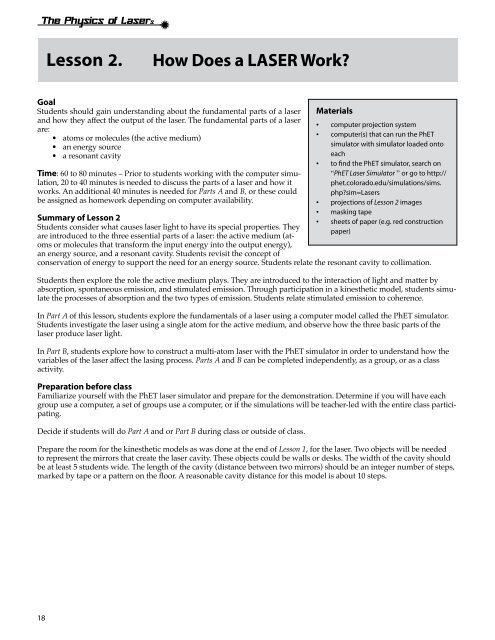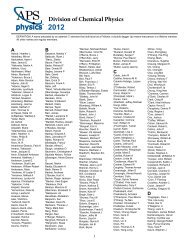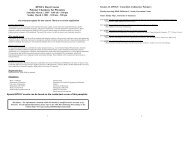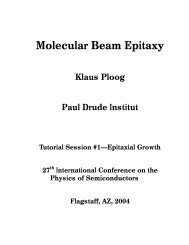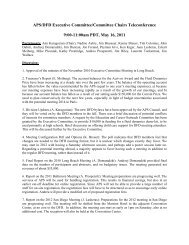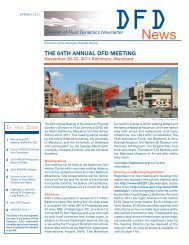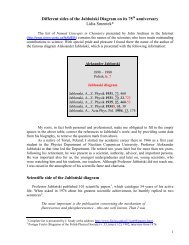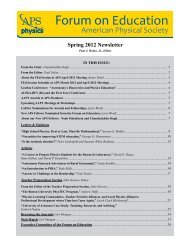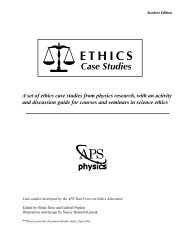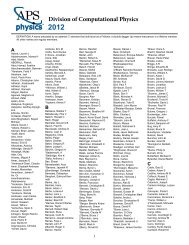The Physics of LASERs - American Physical Society
The Physics of LASERs - American Physical Society
The Physics of LASERs - American Physical Society
You also want an ePaper? Increase the reach of your titles
YUMPU automatically turns print PDFs into web optimized ePapers that Google loves.
18<br />
Lesson 2.<br />
How Does a LASER Work?<br />
Goal<br />
Students should gain understanding about the fundamental parts <strong>of</strong> a laser<br />
and how they affect the output <strong>of</strong> the laser. <strong>The</strong> fundamental parts <strong>of</strong> a laser<br />
are:<br />
• atoms or molecules (the active medium)<br />
• an energy source<br />
• a resonant cavity<br />
Time: 60 to 80 minutes – Prior to students working with the computer simulation,<br />
20 to 40 minutes is needed to discuss the parts <strong>of</strong> a laser and how it<br />
works. An additional 40 minutes is needed for Parts A and B, or these could<br />
be assigned as homework depending on computer availability.<br />
Summary <strong>of</strong> Lesson 2<br />
Students consider what causes laser light to have its special properties. <strong>The</strong>y<br />
are introduced to the three essential parts <strong>of</strong> a laser: the active medium (atoms<br />
or molecules that transform the input energy into the output energy),<br />
an energy source, and a resonant cavity. Students revisit the concept <strong>of</strong><br />
conservation <strong>of</strong> energy to support the need for an energy source. Students relate the resonant cavity to collimation.<br />
Students then explore the role the active medium plays. <strong>The</strong>y are introduced to the interaction <strong>of</strong> light and matter by<br />
absorption, spontaneous emission, and stimulated emission. Through participation in a kinesthetic model, students simulate<br />
the processes <strong>of</strong> absorption and the two types <strong>of</strong> emission. Students relate stimulated emission to coherence.<br />
In Part A <strong>of</strong> this lesson, students explore the fundamentals <strong>of</strong> a laser using a computer model called the PhET simulator.<br />
Students investigate the laser using a single atom for the active medium, and observe how the three basic parts <strong>of</strong> the<br />
laser produce laser light.<br />
In Part B, students explore how to construct a multi-atom laser with the PhET simulator in order to understand how the<br />
variables <strong>of</strong> the laser affect the lasing process. Parts A and B can be completed independently, as a group, or as a class<br />
activity.<br />
Preparation before class<br />
Familiarize yourself with the PhET laser simulator and prepare for the demonstration. Determine if you will have each<br />
group use a computer, a set <strong>of</strong> groups use a computer, or if the simulations will be teacher-led with the entire class participating.<br />
Decide if students will do Part A and or Part B during class or outside <strong>of</strong> class.<br />
Materials<br />
• computer projection system<br />
• computer(s) that can run the PhET<br />
simulator with simulator loaded onto<br />
each<br />
• to find the PhET simulator, search on<br />
“PhET Laser Simulator ” or go to http://<br />
phet.colorado.edu/simulations/sims.<br />
php?sim=Lasers<br />
• projections <strong>of</strong> Lesson 2 images<br />
• masking tape<br />
• sheets <strong>of</strong> paper (e.g. red construction<br />
paper)<br />
Prepare the room for the kinesthetic models as was done at the end <strong>of</strong> Lesson 1, for the laser. Two objects will be needed<br />
to represent the mirrors that create the laser cavity. <strong>The</strong>se objects could be walls or desks. <strong>The</strong> width <strong>of</strong> the cavity should<br />
be at least 5 students wide. <strong>The</strong> length <strong>of</strong> the cavity (distance between two mirrors) should be an integer number <strong>of</strong> steps,<br />
marked by tape or a pattern on the floor. A reasonable cavity distance for this model is about 10 steps.


